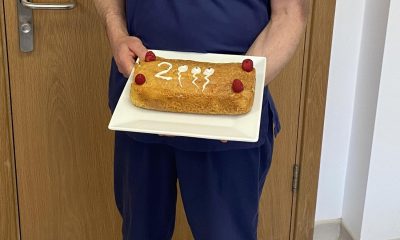By Mark Waghorn via SWNS
Crippling heel pain, which affects about one in ten people, could be treated with injections of a patient's own fat.
Plantar fasciitis blights the lives of millions of people in the US - and can last for years.
It's also known as policeman's foot because it is traditionally associated with lots of walking and standing.
A cure could lie in the sufferer's belly - or another body part, according to new research.
via GIPHY
Plastic surgeon Professor Jeffrey Gusenoff, of the University of Pittsburgh, said: "We developed this procedure to harness the regenerative properties of fat.
"In this proof-of-concept study, we showed fat injections into the foot reduced heel pain, helped patients get back to doing sports and activities and boosted quality of life."
The agonizing condition occurs when the plantar fascia, a ligament that runs along the bottom of the foot, tears.
It can be very slow to heal owing to poor blood supply - leaving some unable to walk or even stand.
The pilot study published in Plastic and Reconstructive Surgery offers hope of relief.
Co-lead author Prof Beth Gusenoff, also from Pitt, said: "Plantar fasciitis is exceptionally painful.
"When you get up from a sitting position or from sleeping it is a sharp, searing pain some people describe as being like a nail going right through their heel."
The husband and wife team's novel technique improved symptoms in more than a dozen patients - opening the door to a larger clinical trial.
Therapies for acute plantar fasciitis (PF) include stretching, shoe orthotics or cortisone jabs.
But about one-in-ten patients progress to the chronic form in which the foot’s collagen degenerates - and the ligament thickens.
Surgical release with a small cut can help - but the operation comes with risks.
Beth said: "Recently, there has been a plea among podiatrists to stop cutting the plantar fascia because some people get a lot of scar tissue, which causes pain.
"And if too much is cut, the foot can become destabilized, so people end up with almost like a floppy foot."
via GIPHY
The Gusenoffs were inspired by the regenerative properties of fat stem cells.
Explained Jeffrey: "In fat, there are stem cells and growth factors that help bring in fresh blood supply, which drives a mode of wound healing with reduced scarring.
"We use a blunt needle to perforate the plantar fascia, which makes a small injury to stimulate the healing process. Then, when we pull the needle back, we inject a little bit of the patient's fat."
The procedure was tested on 14 patients followed for a year. Half received it at the beginning of the study and the others after six months.
The former group had improvements in quality of life and sports activity, decreased plantar fascia thickness and reduced pain levels.
Jeffrey said: "And a lot of the measures that were improving six months after the procedure got even better by 12 months."
Similarly, the latter showed decreased plantar fascia thickness, increased sports activity and a slight improvement in pain levels.
With a larger sample size and a longer follow-up period, it's likely the results would be even better.
They provide proof-of-concept that fat injections can treat PF. The couple are already planning a larger clinical trial to validate the findings.
They hope the procedure will be deemed a medical necessity so it can be covered by insurance and become more widely available in the future.
In previous work, the Gusenoffs showed fat injections can combat loss of pads that cushion the ball of the foot and heel.

 Parenting1 week ago
Parenting1 week ago
 Lifestyle7 days ago
Lifestyle7 days ago
 Wildlife3 days ago
Wildlife3 days ago
 Good News4 days ago
Good News4 days ago
 Health4 days ago
Health4 days ago
 Broadcast1 week ago
Broadcast1 week ago
 Environment1 week ago
Environment1 week ago
 Work2 days ago
Work2 days ago






















